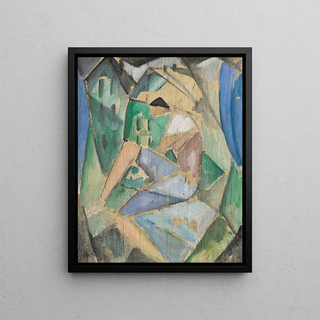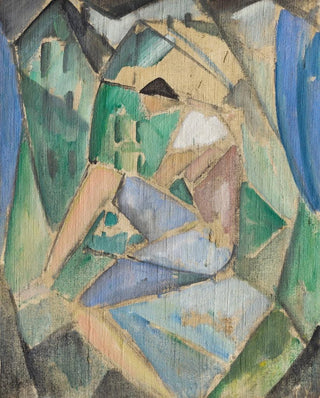Cubist art print with houses - Hermann Stenner


View from behind

Frame (optional)
In the fascinating world of modern art, some artworks stand out for their ability to capture the essence of an era while foreshadowing future movements. The "Art print cubist figure with houses" by Hermann Stenner is one of those creations that, through its boldness and innovation, immerses us in a universe where reality is deconstructed to reveal a new vision of the world. In this piece, the artist skillfully plays with shapes, colors, and perspectives, inviting the viewer to a visual exploration that transcends the limits of traditional representation. By immersing oneself in this work, one feels an invitation to rethink our relationship with space and structure, while discovering the richness of emotions that art can evoke.
Style and uniqueness of the work
The "Art print cubist figure with houses" is distinguished by its bold approach to cubism, an artistic movement that revolutionized aesthetic conventions in the early 20th century. Stenner, as a fervent adherent of this style, uses geometric shapes and vivid colors to create a dynamic and intriguing composition. The houses, depicted from multiple angles, seem to blend and deform, illustrating the complexity of urban life. The angular lines and superimposed planes invite an active reading of the piece, where each glance can reveal new details and interpretations. This non-linear approach to representation allows the viewer to engage in a dialogue with the work, transforming each contemplation into a unique and personal experience.
The artist and his influence
Hermann Stenner, though less known than some of his contemporaries, played a significant role in the development of cubism in Germany. His artistic journey, marked by an incessant quest for innovation, reflects a deep reflection on the social and cultural transformations of his time. Influenced by artists such as Picasso and Braque, Stenner was able to develop a unique visual language, where experimentation and the search for new forms of expression occupy a central place. His work, although sometimes little known, continues to inspire many contemporary artists who see in him a pioneer of modernity.

Matte finish

View from behind

Frame (optional)
In the fascinating world of modern art, some artworks stand out for their ability to capture the essence of an era while foreshadowing future movements. The "Art print cubist figure with houses" by Hermann Stenner is one of those creations that, through its boldness and innovation, immerses us in a universe where reality is deconstructed to reveal a new vision of the world. In this piece, the artist skillfully plays with shapes, colors, and perspectives, inviting the viewer to a visual exploration that transcends the limits of traditional representation. By immersing oneself in this work, one feels an invitation to rethink our relationship with space and structure, while discovering the richness of emotions that art can evoke.
Style and uniqueness of the work
The "Art print cubist figure with houses" is distinguished by its bold approach to cubism, an artistic movement that revolutionized aesthetic conventions in the early 20th century. Stenner, as a fervent adherent of this style, uses geometric shapes and vivid colors to create a dynamic and intriguing composition. The houses, depicted from multiple angles, seem to blend and deform, illustrating the complexity of urban life. The angular lines and superimposed planes invite an active reading of the piece, where each glance can reveal new details and interpretations. This non-linear approach to representation allows the viewer to engage in a dialogue with the work, transforming each contemplation into a unique and personal experience.
The artist and his influence
Hermann Stenner, though less known than some of his contemporaries, played a significant role in the development of cubism in Germany. His artistic journey, marked by an incessant quest for innovation, reflects a deep reflection on the social and cultural transformations of his time. Influenced by artists such as Picasso and Braque, Stenner was able to develop a unique visual language, where experimentation and the search for new forms of expression occupy a central place. His work, although sometimes little known, continues to inspire many contemporary artists who see in him a pioneer of modernity.






